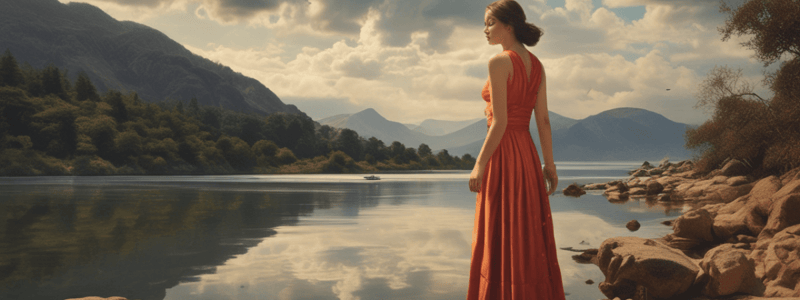Podcast
Questions and Answers
What is a key consideration when shooting Panos?
What is a key consideration when shooting Panos?
- Using a wide-angle lens to capture the entire scene
- Starting from the left and yawing to the right with 60-80% overlap (correct)
- Using a tripod to avoid camera shake
- Taking photos in burst mode to reduce camera movement
What is the purpose of creating an HDR of each stack in the post-production process?
What is the purpose of creating an HDR of each stack in the post-production process?
- To reduce noise in the individual photos
- To enhance the dynamic range of each stack (correct)
- To combine the HDRs from individual stacks
- To create a single Pano from the individual stacks
When is it time to fly the drone back home?
When is it time to fly the drone back home?
- When the drone's battery level reaches 3.6 volts per cell (correct)
- When the drone has reached its maximum distance
- When the drone has reached its maximum altitude
- When the drone's battery level reaches 50% capacity
What is the recommended overlap between frames when shooting Panos?
What is the recommended overlap between frames when shooting Panos?
Why should you turn off downward obstacle avoidance sensors when landing a drone?
Why should you turn off downward obstacle avoidance sensors when landing a drone?
What is the purpose of using a landing pad when operating a drone?
What is the purpose of using a landing pad when operating a drone?
How much linear feet does a drone have to fly home safely when the battery level reaches 3.6 volts per cell?
How much linear feet does a drone have to fly home safely when the battery level reaches 3.6 volts per cell?
Shooting Panos involves taking a single photo of a scene.
Shooting Panos involves taking a single photo of a scene.
It's recommended to use landscape mode to shoot Panos.
It's recommended to use landscape mode to shoot Panos.
Combining individual HDRs creates a single HDR.
Combining individual HDRs creates a single HDR.
A drone can safely land in grass without damaging its gimbal and motors.
A drone can safely land in grass without damaging its gimbal and motors.
When a drone's battery level reaches 3.6 volts per cell, it has unlimited distance to fly home safely.
When a drone's battery level reaches 3.6 volts per cell, it has unlimited distance to fly home safely.
Flashcards are hidden until you start studying
Study Notes
Shooting Panoramas (Panos)
- Shooting Panos is one of the most profitable photography endeavors
- It involves taking multiple photos from different angles and stitching them together
- Use sport mode to shoot Panos, and start from the left, focusing on one point, then yaw to the right about 20% of the image, ensuring 60-80% overlap with the previous frame
- Repeat the process, moving to the right, until the entire scene is captured
Post-Production Process
- Import photos into Lightroom and stack them together
- Create an HDR of each stack
- Combine the HDRs from individual stacks to create a single Pano
Drone Operations
- Always monitor the drone's battery level during flight
- When the battery level reaches 3.6 volts per cell, it's time to fly home
- The drone has about 2,000 linear feet to fly home safely at this voltage level
- Turn off downward obstacle avoidance sensors when landing to prevent the drone from lifting out of your hand
- Avoid landing in grass, as it can damage the gimbal and motors
- Use a landing pad to prevent dust and dirt from entering the motors and obstacle avoidance sensors
Shooting Panoramas (Panos)
- Shooting Panos is a highly profitable photography genre.
- It involves capturing multiple photos from different angles and stitching them together.
- To shoot a Pano, use sport mode, starting from the left, focusing on one point, and then yaw to the right about 20% of the image.
- Ensure 60-80% overlap with the previous frame before moving to the right and repeating the process until the entire scene is captured.
Post-Production Process
- Import photos into Lightroom and stack them together.
- Create an HDR of each stack.
- Combine the HDRs from individual stacks to create a single Pano.
Drone Operations
- Monitor the drone's battery level during flight.
- Return to base when the battery level reaches 3.6 volts per cell.
- At this voltage level, the drone has about 2,000 linear feet to fly home safely.
- Turn off downward obstacle avoidance sensors when landing to prevent the drone from lifting out of your hand.
- Avoid landing in grass as it can damage the gimbal and motors.
- Use a landing pad to prevent dust and dirt from entering the motors and obstacle avoidance sensors.
Shooting Panoramas (Panos)
- Shooting Panos is a highly profitable photography genre.
- It involves capturing multiple photos from different angles and stitching them together.
- To shoot a Pano, use sport mode, starting from the left, focusing on one point, and then yaw to the right about 20% of the image.
- Ensure 60-80% overlap with the previous frame before moving to the right and repeating the process until the entire scene is captured.
Post-Production Process
- Import photos into Lightroom and stack them together.
- Create an HDR of each stack.
- Combine the HDRs from individual stacks to create a single Pano.
Drone Operations
- Monitor the drone's battery level during flight.
- Return to base when the battery level reaches 3.6 volts per cell.
- At this voltage level, the drone has about 2,000 linear feet to fly home safely.
- Turn off downward obstacle avoidance sensors when landing to prevent the drone from lifting out of your hand.
- Avoid landing in grass as it can damage the gimbal and motors.
- Use a landing pad to prevent dust and dirt from entering the motors and obstacle avoidance sensors.
Studying That Suits You
Use AI to generate personalized quizzes and flashcards to suit your learning preferences.




